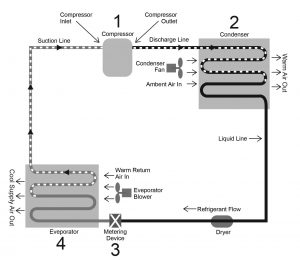Refrigeration Cycle
 A thermodynamic cycle designed to move heat from a cold place to a warm place. For any refrigeration system to operate economically, the refrigerant must be used repeatedly. For this reason, all heat pumps use the same cycle of compression, condensation, expansion, and evaporation in a closed circuit. The same refrigerant is used to move the heat from one area, to cool this area, and to expel this heat in another location. (Examples: air conditioning and refrigeration systems.)
A thermodynamic cycle designed to move heat from a cold place to a warm place. For any refrigeration system to operate economically, the refrigerant must be used repeatedly. For this reason, all heat pumps use the same cycle of compression, condensation, expansion, and evaporation in a closed circuit. The same refrigerant is used to move the heat from one area, to cool this area, and to expel this heat in another location. (Examples: air conditioning and refrigeration systems.)
The following steps occur in a refrigeration cycle:
1) The refrigerant comes into the compressor as a low-pressure gas and is compressed until it moves out of the compressor as a high-pressure gas.
2) The gas flows to the condenser where it condenses to a liquid and gives off its heat to the outside air.
3) The liquid moves to the expansion valve under high pressure. The expansion valve restricts the flow of the fluid, which lowers its pressure.
4) The low-pressure liquid moves to the evaporator where heat from the inside air is absorbed and changes it from a liquid to a gas.
5) As a heated, low-pressure gas, the refrigerant returns to the compressor where the entire cycle is repeated.
